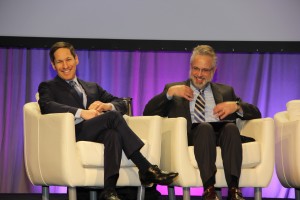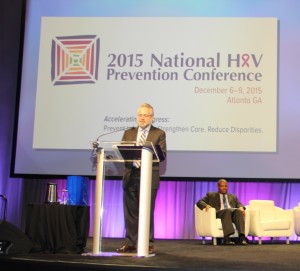2015 National HIV Prevention Conference – Closing Reflections
Topics

As the 2015 National HIV Prevention Conference came to a close earlier this week in Atlanta, we heard from the CDC Director, Dr. Tom Frieden. He highlighted some of the ideas he and colleagues shared in a recent New England Journal of Medicine commentary, “Applying Public Health Principles to the HIV Epidemic - How Are We Doing?Exit Disclaimer"
Dr. Frieden observed that we’ve made important progress in our response to HIV. Recapping some of the promising indicators of progress shared earlier in the conference by CDC’s Dr. Eugene McCray, Director of the Division of HIV/AIDS Prevention, Frieden pointed to a decline in the annual number of new HIV infections, a decrease in the number of people estimated to have undiagnosed HIV infection, and fewer AIDS-related deaths each year. But he underscored that amidst these promising trends, there are a number of troublesome signs. These include the fact that individuals newly diagnosed with HIV are younger and most often gay, bisexual or other men who have sex with men (MSM), with especially troubling rates of new HIV infections among young MSM.

Also of significant concern is the proportion of people with diagnosed HIV infection who are not receiving care or antiretroviral therapy (ART). This is troublesome not only because of the poor prognosis of untreated HIV infection but also because recent CDC analyses indicate that most new HIV infections in the U.S. are transmitted by individuals who are diagnosed but not in care. This issue highlights a treatment gap that has been the focus of considerable effort over the past few years and must continue to be an area of intense focus in communities across the nation. Frieden observed that here, too, we see a disparity among young men: only 1 out of 5 young men living with HIV is on treatment.
Another area requiring our attention, he observed, is the increase in the injection of opiates that is widespread across the country. Brought into the spotlight by the HIV and HCV outbreak in Scott County, Indiana, earlier this year, CDC’s Director explained that their circumstances are not especially unique and that, in fact, CDC estimates show that at least 200 communities in 26 states are vulnerable to a similar outbreak attributable to unsafe injection practices.
To sustain and continue the progress achieved and to address the concerning issues cited, Frieden encouraged the application of public health approaches including:
- Effective surveillance and partner notification.
- Prompt diagnosis and linkage to continuous care, which requires addressing housing, mental health, drug treatment, and other needs people have.
- Continuing to scale up evidence-based primary HIV prevention, making condoms and syringe exchange programs available where they currently are not, and scaling up the use of pre-exposure prophylaxis (PrEP).
- Advocating for societal change to reduce HIV-related stigma.
In addition to using these approaches, he concluded that stopping HIV will require improved health care and better collaboration between health care and public health.
My Closing Reflections

I had the honor of sharing some reflections to close the 2015 conference, a national convening that I initiated back in 1999 while at the CDC. Echoing what several of the presenters observed throughout the conference, the science and practice of HIV prevention have come a long way over the last three decades. The knowledge and tools we have today could hardly have been imagined in those early days of the epidemic when AIDS relentlessly robbed us of friends and family. Though painful to recollect, we do well not to forget that time or the lessons that experience taught us as it continues to have relevance to our work today.
While the many scientific advances in our understanding of HIV/AIDS and its prevention and treatment are truly extraordinary, we must, I told the audience, face the stark truth that we will not “research” our way out of this epidemic.
The men and women here in U.S. and around the world who have made these scientific advances possible by working in labs, hospitals, and communities, and conducting or participating in clinical trials that have brought those many advances to fruition deserve our gratitude and respect for the work they have done and must continue to do as we strive to achieve a world free of AIDS.
Science by itself will not end this epidemic because AIDS has always been about much more than a nasty retrovirus that attacks the human immune system. AIDS was and is a disease that thrives on social inequalities, a virus that takes advantage of our ignorance, prejudice, and intolerance to prey most heavily on those who lack the awareness, capacity and resources to challenge the virus.
I am not the first to observe this deadly interaction between HIV and society. Perhaps the most well-known proponent of AIDS as a truly social disease was the late, great Jonathan Mann, who taught us that we cannot address AIDS without addressing the human rights of our most vulnerable citizens. And that’s what I mean by saying we won’t “research” our way out of the AIDS epidemic
I encouraged the conference attendees—and also encourage the readers of this blog—to continue your important work to integrate new science and technology into your HIV policies and programs, but to never forget that we must also continue to:
- Cultivate strong leadership;
- Mobilize communities;
- Promote a shared vision of ending AIDS; and
- Keep empowering vulnerable populations to achieve social and health equity.
So, as I prepare to retire from Federal service after 27 years working on our national response to HIV, I leave you with these concluding thoughts. It has been my privilege to be able to share information and ideas about our national response to HIV as well as viral hepatitis here on the HIV.gov blog for the last five and a half years. As I move on to my next chapter in public health academia, I look forward to reading this blog to learn about your continued progress towards achieving the goals of the National HIV/AIDS Strategy and the Viral Hepatitis Action Plan. Remember the words of Gandhi: “You must be the change you wish to see in the world” and never stop working for a world free of HIV and viral hepatitis.